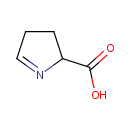
L-D-1-Pyrroline-5-carboxylic acid (PAMDB000329)
| Record Information | |||||||||||||||||||||||||||||||||||||||||||||||||||||||||||||
|---|---|---|---|---|---|---|---|---|---|---|---|---|---|---|---|---|---|---|---|---|---|---|---|---|---|---|---|---|---|---|---|---|---|---|---|---|---|---|---|---|---|---|---|---|---|---|---|---|---|---|---|---|---|---|---|---|---|---|---|---|---|
| Version | 1.0 | ||||||||||||||||||||||||||||||||||||||||||||||||||||||||||||
| Update Date | 1/22/2018 11:54:54 AM | ||||||||||||||||||||||||||||||||||||||||||||||||||||||||||||
| Metabolite ID | PAMDB000329 | ||||||||||||||||||||||||||||||||||||||||||||||||||||||||||||
| Identification | |||||||||||||||||||||||||||||||||||||||||||||||||||||||||||||
| Name: | L-D-1-Pyrroline-5-carboxylic acid | ||||||||||||||||||||||||||||||||||||||||||||||||||||||||||||
| Description: | (S)-1-Pyrroline-5-carboxylate Pyrroline 5-carboxylate is an enamine or an imino acid that forms on spontaneous dehydration of L-glutamate γ-semialdehyde in aqueous solutions. The stereoisomer (S)-1-Pyrroline-5-carboxylate is an intermediate in glutamate metabolism, in arginine degradation and in proline biosynthesis and degradation and it can be converted to or be formed from the three amino acids L-glutamate, L-ornithine and L-proline. In particular, it is synthesized with the oxidation of proline by pyrroline-5-carboxylate reductase 1 (EC 1.5.1.2, PYCR1) or by proline dehydrogenase (EC 1.5.99.8, PRODH) and it is hydrolyzed to L-glutamate by delta-1-pyrroline-5-carboxylate dehydrogenase (EC 1.5.1.12, ALDH4A1). It is also one of the few metabolites that can be a precursor to other metabolites of both the urea cycle and the tricarboxylic acid (TCA) cycle. | ||||||||||||||||||||||||||||||||||||||||||||||||||||||||||||
| Structure | |||||||||||||||||||||||||||||||||||||||||||||||||||||||||||||
| Synonyms: |
| ||||||||||||||||||||||||||||||||||||||||||||||||||||||||||||
| Chemical Formula: | C5H7NO2 | ||||||||||||||||||||||||||||||||||||||||||||||||||||||||||||
| Average Molecular Weight: | 113.1146 | ||||||||||||||||||||||||||||||||||||||||||||||||||||||||||||
| Monoisotopic Molecular Weight: | 113.047678473 | ||||||||||||||||||||||||||||||||||||||||||||||||||||||||||||
| InChI Key: | DWAKNKKXGALPNW-UHFFFAOYSA-N | ||||||||||||||||||||||||||||||||||||||||||||||||||||||||||||
| InChI: | InChI=1S/C5H7NO2/c7-5(8)4-2-1-3-6-4/h3-4H,1-2H2,(H,7,8) | ||||||||||||||||||||||||||||||||||||||||||||||||||||||||||||
| CAS number: | 2906-39-0 | ||||||||||||||||||||||||||||||||||||||||||||||||||||||||||||
| IUPAC Name: | 3,4-dihydro-2H-pyrrole-2-carboxylic acid | ||||||||||||||||||||||||||||||||||||||||||||||||||||||||||||
| Traditional IUPAC Name: | 1-pyrroline-5-carboxylic acid | ||||||||||||||||||||||||||||||||||||||||||||||||||||||||||||
| SMILES: | OC(=O)C1CCC=N1 | ||||||||||||||||||||||||||||||||||||||||||||||||||||||||||||
| Chemical Taxonomy | |||||||||||||||||||||||||||||||||||||||||||||||||||||||||||||
| Taxonomy Description | This compound belongs to the class of organic compounds known as alpha amino acids and derivatives. These are amino acids in which the amino group is attached to the carbon atom immediately adjacent to the carboxylate group (alpha carbon), or a derivative thereof. | ||||||||||||||||||||||||||||||||||||||||||||||||||||||||||||
| Kingdom | Organic compounds | ||||||||||||||||||||||||||||||||||||||||||||||||||||||||||||
| Super Class | Organic acids and derivatives | ||||||||||||||||||||||||||||||||||||||||||||||||||||||||||||
| Class | Carboxylic acids and derivatives | ||||||||||||||||||||||||||||||||||||||||||||||||||||||||||||
| Sub Class | Amino acids, peptides, and analogues | ||||||||||||||||||||||||||||||||||||||||||||||||||||||||||||
| Direct Parent | Alpha amino acids and derivatives | ||||||||||||||||||||||||||||||||||||||||||||||||||||||||||||
| Alternative Parents | |||||||||||||||||||||||||||||||||||||||||||||||||||||||||||||
| Substituents |
| ||||||||||||||||||||||||||||||||||||||||||||||||||||||||||||
| Molecular Framework | Aliphatic heteromonocyclic compounds | ||||||||||||||||||||||||||||||||||||||||||||||||||||||||||||
| External Descriptors | Not Available | ||||||||||||||||||||||||||||||||||||||||||||||||||||||||||||
| Physical Properties | |||||||||||||||||||||||||||||||||||||||||||||||||||||||||||||
| State: | Solid | ||||||||||||||||||||||||||||||||||||||||||||||||||||||||||||
| Charge: | -1 | ||||||||||||||||||||||||||||||||||||||||||||||||||||||||||||
| Melting point: | Not Available | ||||||||||||||||||||||||||||||||||||||||||||||||||||||||||||
| Experimental Properties: |
| ||||||||||||||||||||||||||||||||||||||||||||||||||||||||||||
| Predicted Properties |
| ||||||||||||||||||||||||||||||||||||||||||||||||||||||||||||
| Biological Properties | |||||||||||||||||||||||||||||||||||||||||||||||||||||||||||||
| Cellular Locations: | Cytoplasm | ||||||||||||||||||||||||||||||||||||||||||||||||||||||||||||
| Reactions: | L-D-1-Pyrroline-5-carboxylic acid + 2 Hydrogen ion + NADPH > NADP + L-Proline FAD + L-Proline > L-D-1-Pyrroline-5-carboxylic acid + FADH2 + Hydrogen ion L-D-1-Pyrroline-5-carboxylic acid + 2 Water + NAD > L-Glutamate + Hydrogen ion + NADH L-Glutamic-gamma-semialdehyde > L-D-1-Pyrroline-5-carboxylic acid + Hydrogen ion + Water L-D-1-Pyrroline-5-carboxylic acid + NADP + 2 Water <> L-Glutamate + NADPH + Hydrogen ion L-Proline + NAD <> L-D-1-Pyrroline-5-carboxylic acid + NADH + Hydrogen ion L-Proline + Acceptor + Quinone <> L-D-1-Pyrroline-5-carboxylic acid + Reduced acceptor + (S)-1-pyrroline-5-carboxylate + Hydroquinone NAD(P)<sup>+</sup> + L-Proline < NAD(P)H + L-D-1-Pyrroline-5-carboxylic acid + Hydrogen ion L-Proline + an oxidized electron acceptor > L-D-1-Pyrroline-5-carboxylic acid + a reduced electron acceptor + Hydrogen ion L-Proline + NAD(P)(+) > L-D-1-Pyrroline-5-carboxylic acid + NAD(P)H 1-Pyrroline-5-carboxylic acid + Hydrogen ion + NADPH + L-D-1-Pyrroline-5-carboxylic acid + NADPH > NADP + L-Proline + L-Proline L-Proline + Ubiquinone-1 + L-Proline > Hydrogen ion + Ubiquinol-1 + 1-Pyrroline-5-carboxylic acid + L-D-1-Pyrroline-5-carboxylic acid | ||||||||||||||||||||||||||||||||||||||||||||||||||||||||||||
| Pathways: | |||||||||||||||||||||||||||||||||||||||||||||||||||||||||||||
| Spectra | |||||||||||||||||||||||||||||||||||||||||||||||||||||||||||||
| Spectra: |
| ||||||||||||||||||||||||||||||||||||||||||||||||||||||||||||
| References | |||||||||||||||||||||||||||||||||||||||||||||||||||||||||||||
| References: |
| ||||||||||||||||||||||||||||||||||||||||||||||||||||||||||||
| Synthesis Reference: | Vogel, Henry J.; Davis, Bernard D. Glutamic g-semialdehyde and D1-pyrroline-5-carboxylic acid, intermediates in the biosynthesis of proline. Journal of the American Chemical Society (1952), 74 109-12. | ||||||||||||||||||||||||||||||||||||||||||||||||||||||||||||
| Material Safety Data Sheet (MSDS) | Not Available | ||||||||||||||||||||||||||||||||||||||||||||||||||||||||||||
| Links | |||||||||||||||||||||||||||||||||||||||||||||||||||||||||||||
| External Links: |
| ||||||||||||||||||||||||||||||||||||||||||||||||||||||||||||

